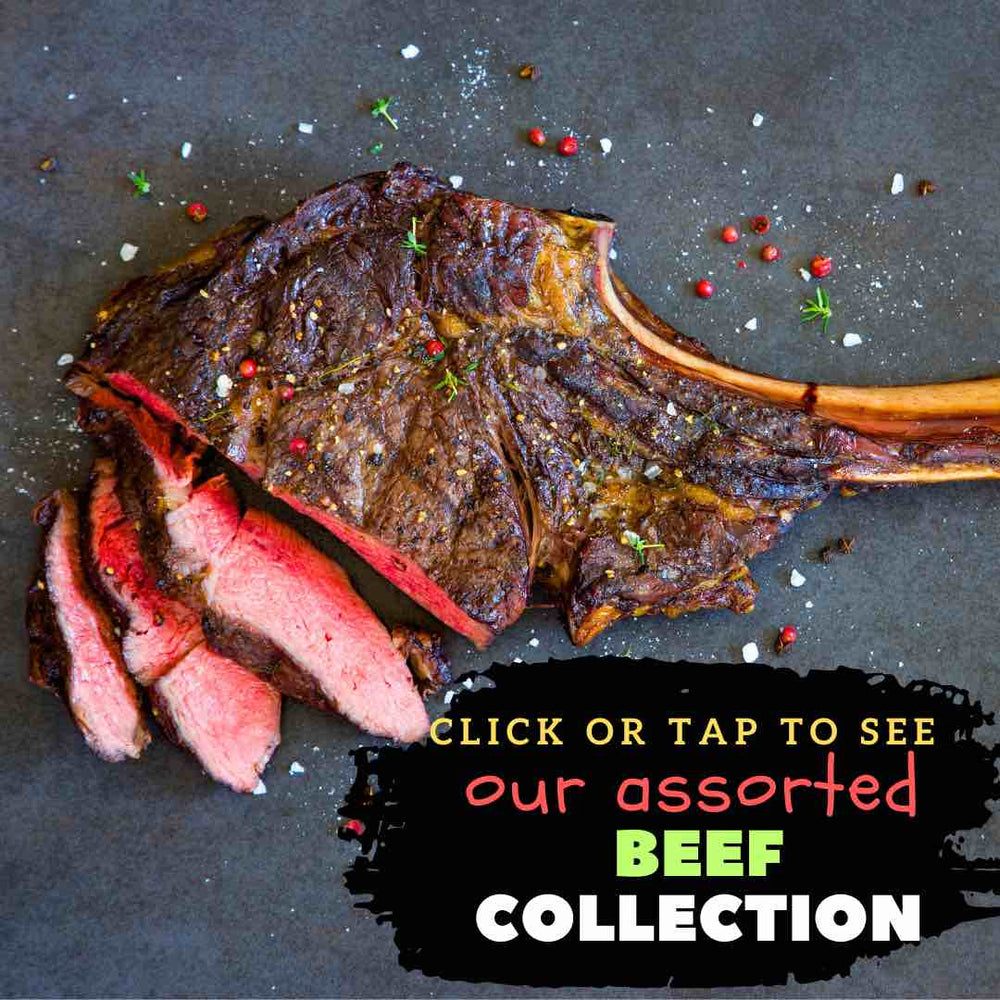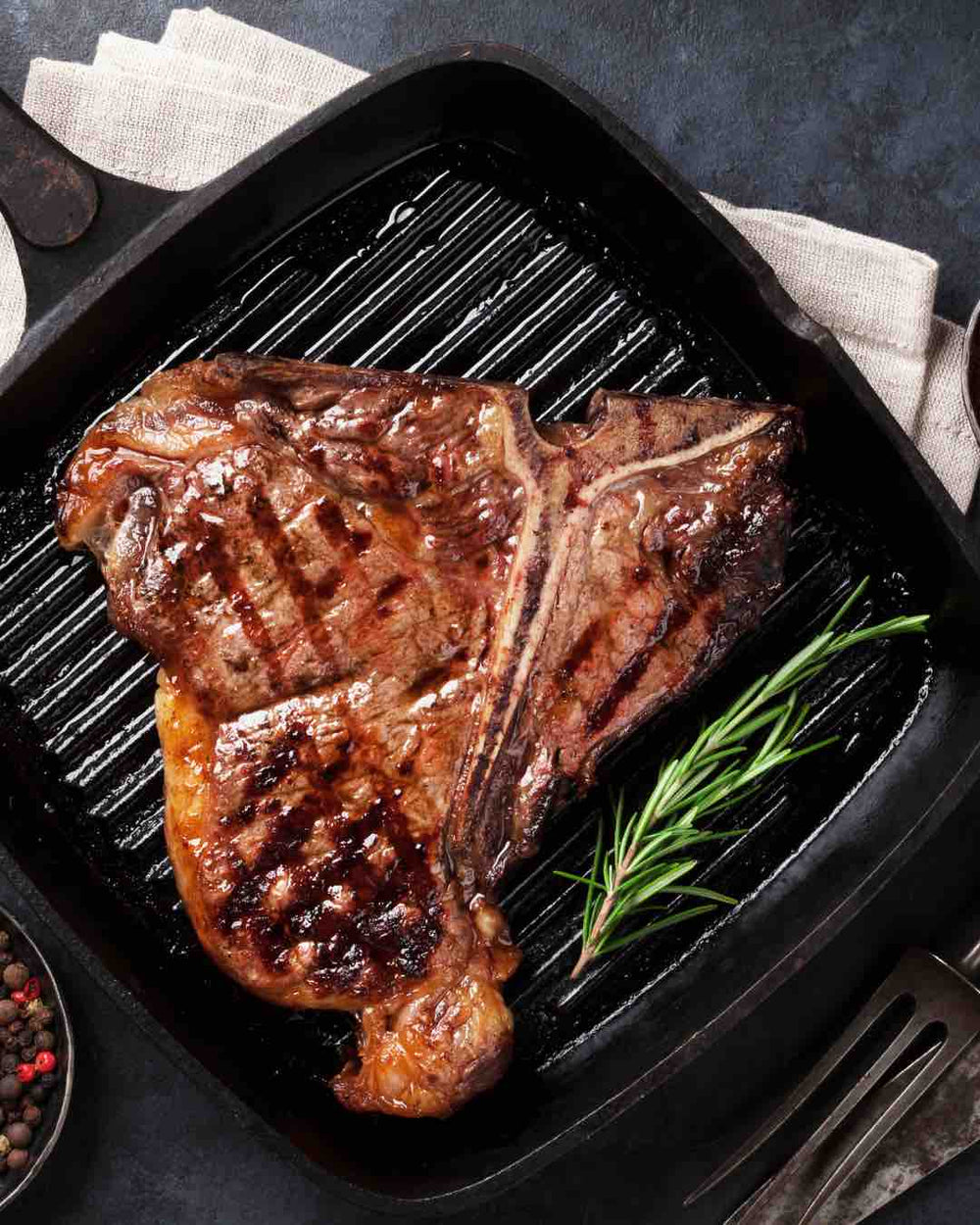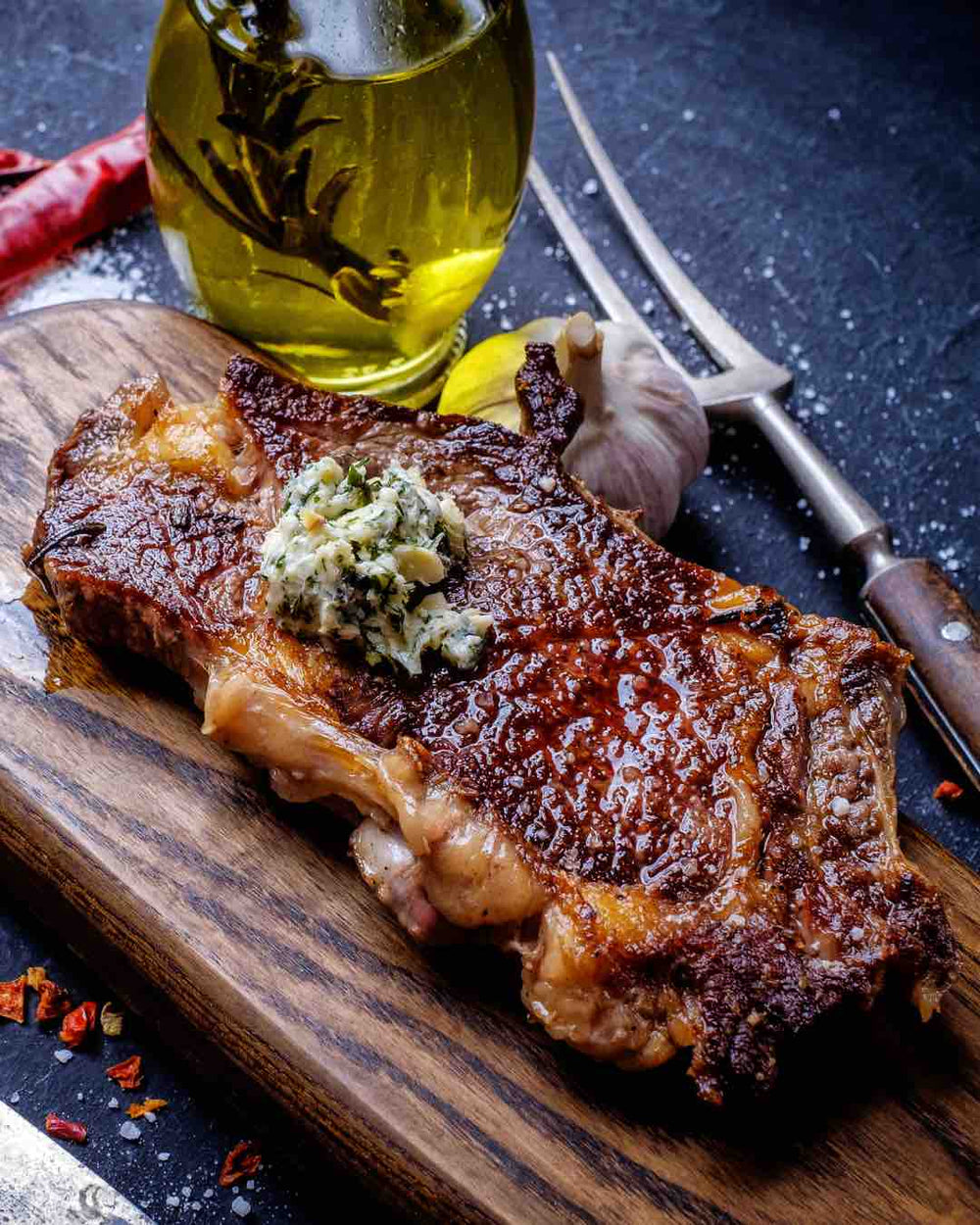
Introduction
Overview Of T-bone And Ribeye Cuts
The T-Bone and Ribeye steaks are two popular cuts of beef that offer distinct flavors and textures. Understanding the differences between these cuts will help you choose the one that best suits your preferences.
The T-Bone steak is named after its distinctive T-shaped bone in the center. It consists of two main sections of meat: the strip steak, also known as the New York strip, and the smaller tenderloin or filet. The strip steak is a larger portion with more marbling, which contributes to its rich flavor and tenderness. On the other hand, the tenderloin is known for its melt-in-your-mouth tenderness and subtle flavor.
The Ribeye steak, also known as the Delmonico steak or rib eye roast, is cut from the rib section of the beef. It is composed primarily of the longissimus dorsi muscle and features a generous amount of marbling, making it incredibly flavorful and juicy. The marbling not only enhances the taste but also ensures a moist and tender texture.
The Allure Of T-bone And Ribeye Steaks
Both T-Bone and Ribeye steaks have their own unique appeal and qualities that make them enticing choices for steak lovers. Here are some of the factors that set them apart:
- Flavor: The T-Bone steak offers a combination of flavors from both the strip steak and the tenderloin. The strip steak is known for its robust, beefy flavor, while the tenderloin offers a more delicate and mild taste. On the other hand, the Ribeye steak has a rich, buttery flavor due to its abundant marbling.
- Tenderness: The T-Bone steak provides a balance of tenderness. The strip steak tends to be more tender than the tenderloin, which can be slightly firmer in texture. In contrast, the Ribeye steak is known for its exceptional tenderness, thanks to the marbling that runs through the meat.
- Cooking methods: Both cuts can be cooked using various methods such as grilling, broiling, or pan-searing. The T-Bone steak is often favored for grilling, as the bone helps retain moisture and adds flavor. The Ribeye steak is excellent for both grilling and pan-searing, as the marbling ensures juiciness and prevents the meat from drying out.
In conclusion, while both T-Bone and Ribeye steaks offer an enjoyable eating experience, they differ in flavor, tenderness, and cooking methods. Understanding these distinctions will help you make an informed decision when choosing the perfect steak for your next meal.
The Anatomy Of T-bone And Ribeye Steaks
Distinctive Features Of T-bone And Ribeye Cuts
The T-Bone and Ribeye steaks have unique characteristics that set them apart:
- T-Bone steak:
- Features a T-shaped bone in the center.
- Consists of two primary meat sections: the strip steak (New York strip) and the tenderloin (filet).
- Strip steak:
- Larger portion with more marbling.
- Offers a robust, beefy flavor.
- Tenderloin:
- Smaller section with a melt-in-your-mouth tenderness.
- Provides a more delicate and mild taste.
- Ribeye steak:
- Cut from the rib section of the beef.
- Primarily composed of the longissimus dorsi muscle.
- Abundant marbling throughout the meat.
- Known for its rich, buttery flavor.
Separation Of Meat Sections In T-bone And Ribeye Steaks
In T-Bone steaks, the T-shaped bone divides the meat into two sections: the strip steak and the tenderloin. The strip steak is the larger portion, offering a robust flavor and more marbling. The tenderloin, on the other hand, is a smaller section with a melt-in-your-mouth tenderness and a milder taste.
In Ribeye steaks, there is no bone dividing the meat. Instead, the entire cut consists of the longissimus dorsi muscle with abundant marbling. This marbling enhances the flavor and ensures a moist and tender texture in the cooked steak.
Both T-Bone and Ribeye steaks have their own allure and appeal to steak lovers. The T-Bone steak offers a combination of flavors from both the strip steak and the tenderloin, providing a balance of robust and delicate tastes. The Ribeye steak, with its generous marbling, delivers a rich, buttery flavor.
Both cuts can be cooked using various methods such as grilling, broiling, or pan-searing. The T-Bone steak is often preferred for grilling due to the bone’s ability to retain moisture and add flavor. The Ribeye steak, on the other hand, is versatile and suitable for both grilling and pan-searing, thanks to its marbling that ensures juiciness and prevents dryness.
Understanding the distinctive features and separation of meat sections in T-Bone and Ribeye steaks allows you to make an informed decision when selecting the perfect cut for your personal preferences and cooking style.
T-bone Steak
Flavor Profile And Tenderness Of T-bone Steak
The T-Bone steak offers a unique flavor profile and tenderness due to its composition. The strip steak, which is the larger portion of the T-Bone, provides a robust, beefy flavor with a hint of fat. On the other hand, the tenderloin section offers a milder, buttery taste. This combination caters to those who appreciate a contrast in flavors within a single steak.
In terms of tenderness, the tenderloin section of the T-Bone is known for its melt-in-your-mouth texture. It is considered one of the most tender cuts of beef and is highly sought after by steak enthusiasts.
Comparing T-bone To Other Cuts
When comparing the T-Bone steak to other cuts, it is important to consider the distinct characteristics and appeal of each. Here are some key points of comparison:
- T-Bone vs Ribeye: Both cuts are highly flavorful, but the T-Bone offers a dual-flavor experience with its two sections, while the Ribeye is known for its rich, buttery flavor throughout.
- T-Bone vs Filet Mignon: The T-Bone includes a portion of the tenderloin, which is also known as filet mignon when cut separately. However, the T-Bone offers the added bonus of the strip steak section, providing a more substantial and diverse eating experience.
- T-Bone vs Sirloin: The T-Bone and Sirloin cuts differ in terms of tenderness. While the T-Bone includes the tenderloin section, making it more tender overall, the Sirloin is a bit less tender but still offers a flavorful and juicy steak option.
In conclusion, the T-Bone steak stands out for its unique combination of flavors and tenderness. Whether you prefer the robustness of the strip steak or the melt-in-your-mouth texture of the tenderloin, the T-Bone offers a satisfying eating experience. When making a choice between different cuts of steak, consider your personal preferences for flavor and tenderness to ensure a delightful meal.

Ribeye Steak
Intense Beefy Flavor And Exceptional Tenderness Of Ribeye
The Ribeye steak is known for its intense beefy flavor and exceptional tenderness. It comes from the rib section of the cow, which is responsible for the rich marbling that gives the steak its juiciness and flavor. The marbling consists of fat that is dispersed throughout the meat, resulting in a buttery texture and a well-rounded taste.
The Ribeye steak is highly regarded for its generous amount of fat, which adds to the overall flavor and juiciness of the meat. The fat melts during cooking, infusing the steak with its distinctive succulence. This makes the Ribeye a popular choice among those who appreciate a rich and decadent steak experience.
Differentiating Ribeye From Other Cuts
When comparing the Ribeye steak to other cuts, there are a few key differences to consider:
- Ribeye vs T-Bone: While both cuts offer intense flavor, the Ribeye is known for its consistent marbling and rich taste throughout the entire steak. The T-Bone, on the other hand, provides a dual-flavor experience with the strip steak on one side and the tenderloin on the other.
- Ribeye vs Filet Mignon: The Ribeye is a fattier cut compared to the leaner Filet Mignon. While the Filet Mignon is prized for its tenderness, the Ribeye offers a more indulgent and robust flavor profile.
- Ribeye vs Sirloin: The Ribeye and Sirloin cuts differ in terms of fat content and tenderness. The Ribeye has more marbling, resulting in a juicier and more flavorful steak. The Sirloin, although leaner, still offers a tasty and satisfying option.
In summary, the Ribeye steak is a prime choice for those seeking a steak with intense beefy flavor and exceptional tenderness. Its generous marbling and rich taste make it a favorite among steak enthusiasts. Consider your personal preferences for flavor and fat content when choosing between different cuts to ensure a delightful meal.
T-bone Vs Ribeye: A Sizzling Showdown
Contrasting The Flavors And Textures Of T-bone And Ribeye
The T-Bone and Ribeye steaks offer distinct flavors and textures that make them popular choices among steak lovers. Here are the key differences between the two:
T-Bone steak:
- The T-Bone steak combines two cuts—the tenderloin and the strip steak—separated by a T-shaped bone.
- It is known for its blend of tenderness and robust flavor.
- The meat from the strip steak side is leaner, offering a firm texture, while the tenderloin is more tender and has a buttery texture.
- The T-Bone steak has a rich, meaty taste with slightly less marbling compared to the Ribeye.
Ribeye steak:
- The Ribeye steak comes from the rib section of the cow and is known for its intense beefy flavor and exceptional tenderness.
- It has generous marbling throughout the meat, resulting in a buttery texture and a well-rounded taste.
- The Ribeye steak is highly regarded for its fat content, which enhances the overall flavor and juiciness of the meat.
- It offers a more indulgent and robust flavor profile compared to the leaner T-Bone.
Factors To Consider When Choosing Between T-bone And Ribeye Steaks
When deciding between a T-Bone and Ribeye steak, consider the following factors:
- Flavor preference: If you enjoy a more intense and well-marbled steak with a buttery texture, the Ribeye is a perfect choice. However, if you prefer a balanced combination of tenderness and flavor, the T-Bone steak may be more suitable.
- Cut preference: The T-Bone steak offers the experience of two different cuts in one, with the strip steak and tenderloin. If you enjoy a variety of flavors and textures, the T-Bone is a great option. On the other hand, if you prefer a consistent taste throughout the entire steak, the Ribeye is the way to go.
- Price: The T-Bone steak is commonly priced at a moderate level, while the Ribeye tends to be slightly more expensive due to its higher fat content and exceptional tenderness.
In conclusion, both the T-Bone and Ribeye steaks have their own unique characteristics and are loved by steak enthusiasts. Consider your personal preferences for flavor, texture, and price when making your choice, and savor a delicious and satisfying steak experience.
Personal Preferences
Exploring Individual Palate And Preferences
When it comes to choosing between T-Bone and Ribeye steaks, personal preferences play a significant role. Each individual has their own unique palate and preferences that can influence their choice. Here are some factors to consider:
How Personal Preferences Impact Choice Between T-bone And Ribeye
1. Flavor preference: Some people prefer a more intense and heavily marbled steak with a buttery texture, which makes the Ribeye a perfect choice. Others may enjoy a balanced combination of tenderness and flavor, making the T-Bone more suitable for their taste.
- Cut preference: The T-Bone steak offers the experience of two different cuts in one, with the strip steak and tenderloin. This allows for a variety of flavors and textures in a single steak. On the other hand, the Ribeye provides a consistent taste throughout the entire steak, which some individuals may prefer.
- Price: Price can also be a determining factor in the choice between T-Bone and Ribeye steaks. The T-Bone steak is commonly priced at a moderate level, making it a more affordable option. The Ribeye, however, tends to be slightly more expensive due to its higher fat content and exceptional tenderness.
Ultimately, the choice between T-Bone and Ribeye steaks comes down to personal preferences and what satisfies an individual’s taste buds. Whether one enjoys the versatility and different textures of the T-Bone or the consistently tender and intensely flavored Ribeye, both steaks offer a mouthwatering journey for steak enthusiasts.
It’s important to consider your own flavor preferences, desired cut experience, and budget when making your selection. By doing so, you can ensure a delicious and satisfying steak experience that caters to your unique palate.

Cooking Techniques For T-bone And Ribeye
Optimal Cooking Methods For T-bone And Ribeye Steaks
When it comes to cooking T-Bone and Ribeye steaks, there are various techniques you can use to bring out their best flavors and textures. Here are some cooking methods that work well for each steak:
T-Bone:
- Grilling: Grilling T-Bone steaks allows for the perfect sear and caramelization, enhancing the robust beefy flavor of the strip steak while maintaining the tenderness of the tenderloin.
- Pan-searing: Pan-searing is an ideal method to cook T-Bone steaks if you prefer a quicker cooking time. This method allows for a nice crust on the outside while keeping the buttery tenderness of the tenderloin intact.
Ribeye:
- Broiling: Broiling Ribeye steaks under high heat results in a deliciously charred crust and a juicy, tender interior. This method is perfect for those who enjoy a well-charred exterior and a medium-rare to medium doneness.
- Reverse searing: Reverse searing involves cooking the Ribeye steak at a low temperature in the oven first, then finishing it off with a quick sear in a hot pan or on the grill. This method ensures even and precise cooking, resulting in a consistent and tender steak.
Enhancing The Flavors Of T-bone And Ribeye Through Cooking
Here are some additional cooking techniques that can further enhance the flavors of T-Bone and Ribeye steaks:
- Marinades and rubs: Using marinades or dry rubs can add an extra layer of flavor to both T-Bone and Ribeye steaks. You can experiment with different seasonings, herbs, and spices to create a delicious marinade or rub that complements the natural flavors of the steak.
- Resting: Allowing the cooked T-Bone or Ribeye steak to rest for a few minutes before serving helps in redistributing the juices, resulting in a more tender and flavorful steak.
- Basting: Basting the steak with melted butter or a flavored oil during cooking can add a richness and depth of flavor to both T-Bone and Ribeye steaks.
By selecting the optimal cooking method and incorporating additional techniques, you can enhance the flavors, textures, and overall enjoyment of T-Bone and Ribeye steaks. Experimenting with different techniques can provide you with a variety of mouthwatering experiences. Enjoy exploring the world of steak cooking and finding your personal favorite method for these flavorful cuts.
Serving Suggestions For T-bone And Ribeye
Pairing T-bone And Ribeye With Complementary Sides And Sauces
When serving T-Bone and Ribeye steaks, it’s essential to choose sides and sauces that complement their rich flavors. Here are some suggestions:
- Sides: For T-Bone and Ribeye, classic steakhouse sides such as mashed potatoes, roasted vegetables, and creamed spinach work well. These sides offer a balance of flavors and textures that complement the steak’s robustness.
- Sauces: T-Bone and Ribeye steaks can be enhanced with flavorful sauces. A traditional steak sauce, such as peppercorn or mushroom sauce, can add depth and richness to both cuts. Additionally, a tangy chimichurri or a creamy horseradish sauce can provide a refreshing contrast to the meat’s richness.
Tips For Serving T-bone And Ribeye Steaks For A Memorable Dining Experience
To ensure a memorable dining experience when serving T-Bone and Ribeye steaks, consider the following tips:
- Temperature: It’s crucial to serve T-Bone and Ribeye steaks at the appropriate temperature. Let the steaks rest after cooking, allowing them to reach an optimal serving temperature. For a medium-rare doneness, the internal temperature should be around 130°F (55°C).
- Presentation: When plating the steaks, consider adding some garnishes such as fresh herbs or a sprinkle of sea salt. This simple touch can elevate the visual appeal and make the dish even more enticing.
- Slicing: When serving T-Bone and Ribeye steaks, it’s advisable to slice them against the grain. This technique helps to enhance tenderness and ease of eating.
- Wine pairing: Pairing T-Bone and Ribeye steaks with the right wine can make the dining experience even more enjoyable. Consider red wine varieties such as Cabernet Sauvignon or Malbec, which complement the rich flavors of the steaks.
By considering these serving suggestions and tips, you can elevate the dining experience when serving T-Bone or Ribeye steaks. Experiment with different sides, sauces, and wine pairings to find the perfect combination that suits your preferences and enhances the flavors of these delicious cuts of meat.
Conclusion
Summarizing Key Points Of The T-bone Vs Ribeye Comparison
- T-Bone and Ribeye steaks are both beloved cuts of beef with their own unique characteristics.
- T-Bone steak features two distinct cuts, the tenderloin and the strip steak, separated by a T-shaped bone, offering a blend of tenderness and robust flavor.
- Ribeye steak is known for its consistently tender, intensely flavored, and marbled meat.
- Both cuts offer a mouthwatering journey for steak lovers.
Making An Informed Decision Based On Personal Preferences And Knowledge
- Ultimately, the choice between T-Bone and Ribeye comes down to personal preferences.
- If you appreciate versatility, various flavors, and the opportunity to experiment with different textures in a single steak, the T-Bone is a good choice.
- However, if you crave a consistently tender, intensely flavored, and marbled steak, the Ribeye is the undisputed champion.
- Consider the serving suggestions, such as pairing with complementary sides and sauces, and serving the steak at the appropriate temperature for a memorable dining experience.
- Experiment with different sides, sauces, and wine pairings to find your perfect combination.
By considering these key points and making an informed decision based on personal preferences and knowledge, you can confidently choose between T-Bone and Ribeye steaks and enjoy a delicious and satisfying meal.
FAQ: T-Bone vs Ribeye – Contrasting T-Bone and Ribeye Cuts
Q: What is the main difference between T-Bone and Ribeye steaks?
A: The main difference lies in the location of the cut on the animal and the amount of bone present. A T-Bone steak is cut from the forward section of the short loin and contains a T-shaped bone. On the other hand, a Ribeye steak is taken from the rib section of the animal and does not have any bone in it.
Q: Which part of the cow does each cut come from?
A: A T-Bone steak is taken from the area between the short loin and the top sirloin, which is closer to the rear end of the cow. A Ribeye steak, as the name suggests, is harvested from the rib section, which is located closer to the front of the animal.
Q: How does the presence of bone affect the taste and cooking process?
A: The bone in a T-Bone steak acts as a heat conductor, giving the meat a richer flavor and contributing to more even cooking. The boneless Ribeye steak, on the other hand, tends to be more tender and juicy due to the higher fat marbling in the meat.
Q: Is one cut more tender than the other?
A: Both T-Bone and Ribeye steaks are known for their tenderness, but the Ribeye is often considered more tender due to its higher fat content. The marbled fat distributes flavor and enhances the tenderness of the meat.
Q: Which cut is better for grilling?
A: Both T-Bone and Ribeye steaks are excellent choices for grilling. However, the larger size of the Ribeye makes it slightly more forgiving in terms of cooking time, as it is less likely to overcook and dry out. The T-Bone steak’s bone can also provide some insulation during the grilling process.
Q: Are T-Bone and Ribeye steaks similar in taste?
A: While both cuts are beefy and have a rich flavor profile, T-Bone steaks tend to have a slightly milder taste compared to the more robust and buttery flavor of Ribeye steaks. The difference in taste can be attributed to the varying fat content and the influence of the bone.
Q: Which cut is more suitable for someone looking for a leaner option?
A: If you are seeking a leaner option, the T-Bone steak might be a better choice. It consists of a strip steak and a smaller portion of tenderloin separated by a bone. The tenderloin, also known as filet mignon, is generally leaner compared to the Ribeye, which has more marbling and fat content.
Q: Can T-Bone and Ribeye steaks be cooked using the same methods?
A: Absolutely! Both T-Bone and Ribeye steaks can be cooked using various methods, including grilling, pan-searing, broiling, or even sous vide. The cooking method will depend on your preference and desired results. Just make sure to adjust the cooking time according to the thickness and doneness you prefer.
In summary, T-Bone and Ribeye steaks have distinctive characteristics that set them apart. The bone in a T-Bone steak contributes to its cooking process and flavor, while the Ribeye’s higher fat content enhances tenderness and juiciness. Both cuts are delicious and can be cooked in different ways, ensuring a wonderful steak experience.

Noel Martinez, the owner of theholygrillsf.com, uses social media to connect with the community and share delicious updates from The Holy Grill. Follow Noel Martinez for mouthwatering food photos, exciting event announcements, and behind-the-scenes glimpses into the world of The Holy Grill. Stay in the loop and never miss out on the latest culinary adventures!